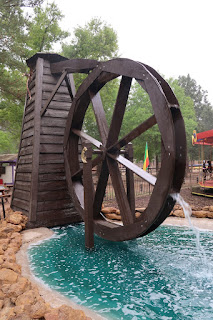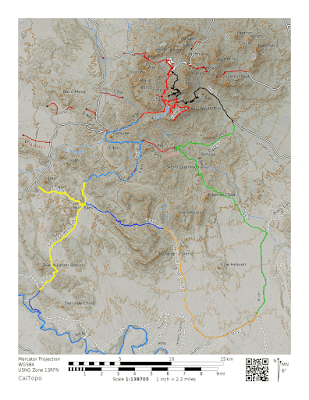A Long-Term Review of the Primus Classic Stove
I have been using this stove for about 5 years as my primary stove, and I’ve never had an issue.
If you want to learn more about different stove types, make sure you check out our previous posts, Stove Basics 1 and Stove Basics 2. When I was getting back into backpacking, I needed an affordable stove, and this was the best option at
REI. This stove is widely available in outdoor stores, but the best price is typically found
on Amazon.
Background
Weight: 8 oz
Size: 2.8x2.4x2.9”
Boil time: approximately 3 min
BTUs: 10,000
Price: $15 to $20
Canister stoves are generally considered lightweight and durable. The fuel source is an isobutane and propane mix in small metal canisters, which is where they get the name canister stove. The canister is generally the heaviest part of the setup and doesn’t get any lighter as you burn fuel. Finally, canister stoves are extremely easy to use and maintain.
How I Use It
I have used this stove for a variety of outdoor activities, including backpacking, hiking, and glamping, and I would often cook lunch while working in the woods. On hiking or backpacking, I bring this along to cook hot breakfast, dinner, and warm drinks. For Glamping and cooking lunch, I have a large isobutane container and cook some well-rounded meals using a 1L pot and skillet lid.
Performance
The Primus Yellowstone has never had any significant performance issues. The stove boils quickly, provides a stable platform, and functions well in adverse weather conditions. Additionally, this stove is incredibly durable. I have never performed maintenance other than halfheartedly wiping it down after use or drying the stove.
Less than Ideal Weather
After years of use, I have rarely seen a decrease in performance in less-than-ideal weather. Out of the hundreds of times I’ve used this stove, I can only remember a single time when the flame was completely extinguished by strong wind. Furthermore, wind will decrease the overall performance; you shouldn’t use a windscreen as it can overheat the fuel canister, but the stove will boil water fine.
I have also been lucky enough to use the Primus Yellowstone stove in light to moderate rains. Rain will decrease the performance of your cook times and make a worrying sizzle sound throughout your entire pot and stove, especially when they are hot; however, I was still able to brave the rain and cook a nice, warm meal in about the same time as ideal conditions.
Boil Time
The Primus Yellowstone is a great source of heat and brings 300 ml of water in an open pot in approximately 4 minutes, and make sure you check out the
boil test. For comparison, Jack’s
Etekcity stove boiled water in 4.5 minutes under the same conditions, and you can view the boil test
here. The Etekcity stove will save you 3 oz, but increase your boil time by around 30 seconds.
I think one of the reasons the Primus Yellowstone stove boils quickly is the larger burner. It works exceptionally well on a wide pot where the large burner creates a lot of heat that doesn't escape out or around the pot.
Stability
The Yellowstone stove has a fixed pot stand with 4 smooth legs, which allows the stove to accommodate pots of all sizes. This ensures the stove has excellent stability. The biggest concern for stability is finding a cook site that is relatively level and free of debris. If you are a beginner and don't have all your gear perfectly dialed in, or for younger/uncoordinated adventures, the great stability and pot size accommodation will significantly smooth the learning curve.
Issues
Overall, the issues with the Primus Yellowstone stove are relatively limited, and for beginner or intermediate backpackers or hikers, this remains a solid investment. Additionally, there are some inherent issues with canister stoves, which are not limited to this stove, but will be addressed nonetheless.
Size and Weight
Over the years, nesting my cook gear has become increasingly important as I’ve learned that a low-volume pack can be just as crucial as a lightweight one. Plus, nesting can reduce the awful noise of metal-on-metal clinking caused by stove, canister, and pot interactions as you walk. In addition to being large, this stove is also considered heavy for canister stoves. You can easily find a stove with a similar boil time at around half the weight.
Fuel Level?
One issue with all canister stoves is that there is no practical way to check fuel levels in the field. I have seen methods for measuring canisters to estimate the remaining fuel and tools that allow you to cannibalize almost empty canisters to refuel another canister. Unfortunately, neither will provide an accurate estimate while out adventuring; therefore, using a canister stove will require a little extra planning if you intend to be out for an extended period.
Weather Issues
Wind is the enemy of all flame, and this is true with canister stoves. There are clever designs and picking good cook sites, but windscreens can’t be used because heat buildup can cause canisters to overheat and explode. Finally, canister stoves have mainly become ineffective in cold weather, so if you live in a cold climate, there are better fuel options available.
Final Recommendation
I have found the Primus Yellowstone stove to perform exceptionally well in diverse scenarios, and this is evident, as I have never replaced this canister stove, despite collecting various new and fancy stoves throughout the years. It’s not a bad stove to start with, given its low cost, simplicity, and reliability, especially for beginners. However, if I had to do it over again, I would consider cheaper and lighter models to be better options. However, this is a great bargain stove for beginners or some good canister stove in a pinch.
What type of stove do you use? Let us know in the comments. Also, if you like the blog, follow us on
Facebook to keep up to date.






Comments
Post a Comment